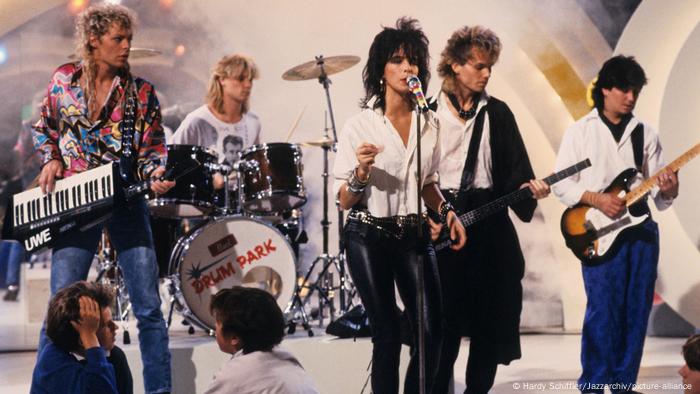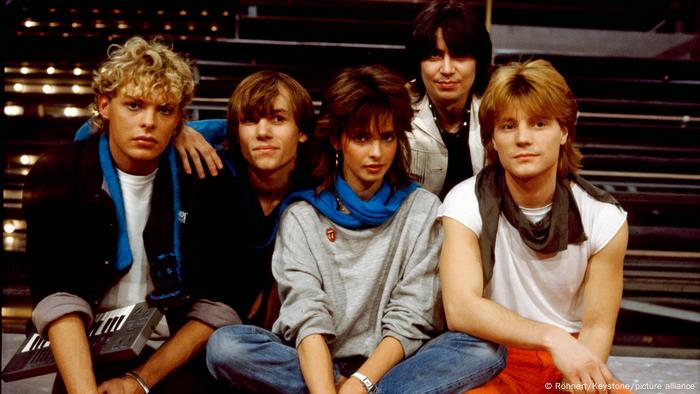Her record company initially did not want to publish the song, but Nena prevailed. “99 Luftballons” became a hit around the world – and in German!
40. Birthday of “99 Luftballons”
In January 1983, shallow pop music dominated the international charts. Phil Collins hits number 1 in the UK with “You Can't Hurry Love”. In the USA Hall & Oates topped the Billboard charts with “Maneater” and Men at Work with “Down Under”. In Germany, Culture Club is celebrated with “Do You Really Want To Hurt Me”.
But at that time there was an alternative to Anglophone superstar pop in the German music scene. It's a new type of music with German lyrics that goes beyond pop music, danceable, with synthesizer sounds, electronic drums – and also a bit crazy. The texts are like comics, colorful, funny and imaginative. Sometimes they're just nonsense. Spliff, Fräulein Menke, Peter Schilling, Trio, Hubert Kah – they all belong to this “New German Wave” and are in the German charts alongside international stars such as Supertramp, Eddie Grant, Dionne Warwick and Phil Collins.
< img src="https://static.dw.com/image/64452258_401.jpg" />
The singer Nena in the 1980s
A message that will go around the world
And then a young woman hops across the stage, with a cheeky face, curly hair, large earrings and a girl's voice. Her name is Gabriele Kerner – called Nena – and she is the singer of the band “Nena”. The is also heavily involved in the charts. And exactly in January 1983, the band showed that Neue Deutsche Welle is more than just punk electronic fun. Nena has a message that will go around the world.
On the debut album “Nena”, which was released on January 14, 1983, there is Nena's first hit “Nur dreamed” as well as the initially naive-sounding “99 Luftballons”. It quickly becomes clear: Here Nena speaks in her own language and the language of the youth, addressing the warmongers who were keeping the world in suspense at the time: the Soviet Union and the USA. Armed to the teeth with nuclear missiles, the two world powers face each other and not only threaten each other, but are also able to destroy the world umpteen times with the explosive power of their weapons.
All because of 99 balloons
In this highly explosive situation, people's greatest fear is that someone might accidentally press the “red button” and trigger nuclear annihilation.

The band “Nena” is named after the nickname of their singer Nena
That's exactly what Nena describes in the song “99 Luftballons”. Someone imagines the war machine starting because some radar has identified harmless balloons as a threat. The situation escalates, all countries are drawn into it, everyone wants war and power – and in the end there is nothing left. The song ends with the lines:
“99 years of war
Left no room for winners
There are no more Ministers of War
And no jet planes either
Today I'm making my rounds< br> See the world in ruins
Found a balloon
Think of you and let it fly.”

Was the song inspired by street artist Banksy?
Record company doesn't see any hit potential
The two songwriters of the band, Uwe Fahrenkrog-Petersen and Carlo Carges († 2002) did not originally get together to write such a song. The whole thing is more of a coincidence. Fahrenkrog-Petersen tries out his new synthesizer, taking inspiration from the electro funk that's just coming out of the US and trying to incorporate that hard-hitting funky groove into the new wave sound that was all the rage at the time. At some point the idea of changing the rhythm comes to him – and that ultimately makes the composition so exciting. Carges had the lyrics in his pocket for a long time – and they just happen to fit this melody.
Singer Nena – is also enthusiastic and, according to Fahrenkrog-Petersen in his blog, contributes her singing with “punk girl attitude”, which “fits perfectly with the profound story and the energetic music”.
The band is convinced of the song and wants to release it as the first single from the new album. But the record company thinks nothing of it. The song has no refrain at all, they say. And with the long instrumental part at the beginning, no radio station will play it.

Uwe Fahrenkrog-Petersen (left) and Carlo Carges (2nd from right) wrote “99 Luftballons”
One-Hit-Wonder Abroad
Eventually, the band prevailed and released the song at the end of January. The song takes off. On March 28, 1983, it reached number 1 in the German charts – and then went around the world: number 1 in Japan, Australia, Canada, Mexico. The German song also became known in the USA. By coincidence, a radio DJ in the USA became aware of it. He plays it so often that it spreads everywhere, eventually reaching #2 on the Billboard charts in December '83. To this day, no German-language title in the USA has gotten higher. In 1984, Nena submitted the song in English – this version reached the top position in the British charts.
An international career never materialized. While Nena is successful with the band and later solo, she remains a one-hit wonder abroad with “99 Luftballons”. But the message remains – and in view of the war in Ukraine, the scenario has come closer than one could have imagined for a long time.